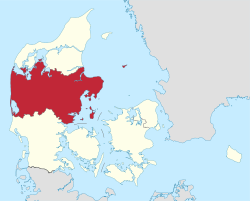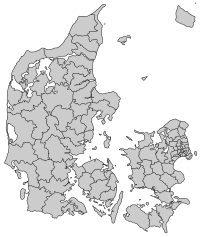Central Denmark Region
Central Denmark Region (Danish: Region Midtjylland), or more directly translated as Central Jutland Region[3] and sometimes simply Mid Jutland,[4][5][6][7] is an administrative region of Denmark established on 1 January 2007 as part of the 2007 Danish Municipal Reform. The reform abolished the traditional counties (amter) and replaced them with five new administrative regions. At the same time, smaller municipalities were merged into larger units, cutting the total number of municipalities from 271 before 1 January 2006, to 98. Central Denmark Region comprises 19 municipalities. The reform diminished the power of the regional level dramatically in favor of the local level and the national government in Copenhagen.
Central Denmark Region Region Midtjylland | |
|---|---|
 Flag | |
 | |
| Country | Denmark |
| Largest city | Aarhus |
| Capital | Viborg |
| Municipalities | |
| Government | |
| • Chairman | Anders Kühnau (Social Democrats) |
| Area | |
| • Total | 13,053 km2 (5,040 sq mi) |
| Population (January 2018)[1] | |
| • Total | 1,313,596 |
| • Density | 100/km2 (260/sq mi) |
| Time zone | UTC+1 (CET) |
| • Summer (DST) | UTC+2 (CEST) |
| HDI (2017) | 0.927[2] very high · 2nd |
| Website | www.rm.dk |
Toponymy
The Danish name of the region means "Region of Mid Jutland" and describes the location in the central part of the Jutland peninsula, in contrast to Northern Jutland and Southern Jutland (which together with Funen and some smaller islands forms the Region of Southern Denmark). For communication in English, the regional administration has decided to use another term which is not a direct translation of the Danish name, supposing that the name Jutland might be too unknown to the English speaking public.
A similar policy is followed by the North Denmark Region (whose Danish name Region Nordjylland translates as "Region of North Jutland").
However, the name of the region is usually untranslated when used in English-language publications not by the regional council itself, but by governmental authorities such as Statistics Denmark. From 2007 to 2013, five so-called State Administrations or governorates existed in Denmark, covering the five regions as separate entities from the regional councils. One of these was named the "State Administration of Central Jutland" in English and covered the same area as the regional council, but had its administration in Ringkøbing as opposed to the regional council in Viborg.
In English-language media and literature by various authors the names Central Jutland (or Mid Jutland) are also commonly used.[8][9]
Geography

Central Denmark Region comprises most of the traditional geographical regions of Østjylland (East Jutland), Midtjylland (Central Jutland), and Vestjylland (West Jutland, identical with Hardsyssel). Smaller areas within these larger designations include the peninsula of Djursland, the hilly lake district of Søhøjlandet, Kronjylland (or Ommersyssel), Fjends, Bjerreherred, and the peninsulas of Salling and Thyholm. The region borders the North Sea in the west, the Limfjord in the northwest, and Kattegat in the east. It includes the islands of Samsø, Anholt, and the smaller Endelave, Tunø, Hjarnø and Alrø in Kattegat, as well as Venø, Jegindø and Fur in the Limfjord.
The western parts of the region are characterised by coastal dunes and inland heaths, while the slightly elevated central parts, and the relatively hilly eastern parts, are characterised by forests, lakes and streams, with plenty of fertile soils. The eastern parts (Østjylland), are the most densely populated area within the region and form a large part of the proposed East Jutland metropolitan area with a population of about 1.4 million.
Århus (population 273,000) is the largest city of Jutland, the second-largest city of Denmark as well as the hub of Eastern Jutland. Other cities with a population above 30,000 include Randers, Silkeborg, Horsens, Herning, Viborg and Holstebro. Most of these are situated in the eastern part. The administration and regional council is situated in the sixth largest city, Viborg (population 41,000), which was also the medieval capital of Jutland.
Administratively, Central Denmark Region consists of the former counties of Ringkjøbing and Århus (except the western half of Mariager municipality which joined Region Nordjylland), most of the former county of Viborg, and the northern half of Vejle County. The areas in question from the two latter counties were the former municipalities of Bjerringbro, Fjends, Hvorslev, Karup, Kjellerup, Møldrup, Sallingsund, Skive, Spøttrup, Sundsøre, Tjele, and Viborg from Viborg County and Brædstrup, Gedved, Hedensted, Horsens, Juelsminde, Nørre-Snede and Tørring-Uldum from Vejle County.
The neighbouring administrative region to the south is called Southern Denmark (Danish: Region Syddanmark), as it includes not only the southern parts of Jutland, but also the island of Funen and smaller neighbouring islands. Furthermore, Sønderjylland (Southern-Jutland) is the traditional name for the Danish part (North Slesvig) of the former Duchy of Schleswig/Slesvig.
Geologically the region lies in the northern part of Denmark which is rising because of post-glacial rebound.
For statistical purposes the region has two divisions or provinces, East Jutland and West Jutland. These are almost, but not entirely, identical with the parliamentary constituencies of East Jutland and West Jutland. The western constituency is much larger in area, but has a smaller population than the eastern one.
Significant local antagonism arose before the region came into effect in 2007 and in the first years of its existence. Citizens in the northwestern areas protested against the closure of the hospital of Holstebro. In the 2009 regional election, a local protest party, Fælleslisten, surged to 40 percent of the votes in the northwestern municipalities, but failed to get any seats in the 2013 election.
Economy
The Gross domestic product (GDP) of the region was 62.2 billion € in 2018, accounting for 20.7% of Denmarks economic output. GDP per capita adjusted for purchasing power was 35,400 € or 117% of the EU27 average in the same year. GDP per person employed was 107% of the EU27 average.[10]
See also
References
- FOLK1: Population 1 October database from Statistics Denmark
- "Sub-national HDI - Area Database - Global Data Lab". hdi.globaldatalab.org. Retrieved 2018-09-13.
- Danish state authorities Archived 2008-03-27 at Archive.today use both the Danish name Midtjylland and the direct translation Central Jutland in English texts. Central Jutland Region or Region of Central Jutland are also widely used by others (e.g. the city of Århus Archived January 24, 2010, at the Wayback Machine), but the Region itself prefers 'Central Denmark'.
- "Visit Denmark – Share Mid Jutland". Archived from the original on 2018-06-25. Retrieved 2018-04-29.
- Cyclistic – Mid Jutland
- [cphpost.dk/news/archaeologists-uncover-medieval-village-in-mid-jutland.html Archaeologists uncover medieval village in mid-Jutland – The Post]
- OECD – Entrepreneurship Review of Denmark - Page 99
- Denmark's regions set to be disbanded after 12 years, thelocal.dk, 16 January 2019
- The Value of Arts and Culture for Regional Development: A Scandinavian Perspective, ed. Lisbeth Lindeborg and Lars Lindquist, Routledge, 2013; p. 64, 65, 68
- "Regional GDP per capita ranged from 30% to 263% of the EU average in 2018". Eurostat.
External links
- Official website (in English)
- Central Denmark Office to the EU (in English)


.svg.png)